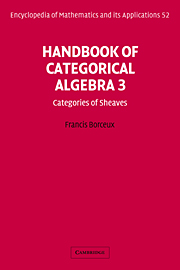Introduction to this handbook
Published online by Cambridge University Press: 04 February 2010
Summary
My concern in writing the three volumes of this Handbook of categorical algebra has been to propose a directly accessible account of what – in my opinion – a Ph.D. student should ideally know of category theory before starting research on one precise topic in this domain. Of course, there are already many good books on category theory: general accounts of the state of the art as it was in the late sixties, or specialized books on more specific recent topics. If you add to this several famous original papers not covered by any book and some important but never published works, you get a mass of material which gives probably a deeper insight in the field than this Handbook can do. But the great number and the diversity of those excellent sources just act to convince me that an integrated presentation of the most relevant aspects of them remains a useful service to the mathematical community. This is the objective of these three volumes.
The first volume presents those basic aspects of category theory which are present as such in almost every topic of categorical algebra. This includes the general theory of limits, adjoint functors and Kan extensions, but also quite sophisticated methods (like categories of fractions or orthogonal subcategories) for constructing adjoint functors. Special attention is also devoted to some refinements of the standard notions, like Cauchy completeness, flat functors, distributors, 2-categories, bicategories, lax-functors, and so on.
- Type
- Chapter
- Information
- Handbook of Categorical Algebra , pp. xv - xviiiPublisher: Cambridge University PressPrint publication year: 1994

